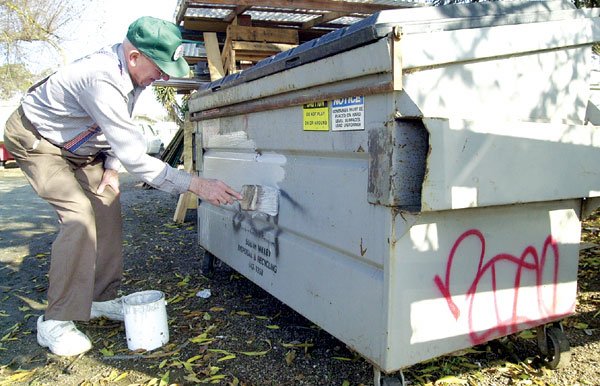GILROY
– Try this. Drive around this city looking for graffiti. Look on
the outer walls of stores, bus-stop benches, telephone poles,
electrical boxes and bridges.
GILROY – Try this. Drive around this city looking for graffiti. Look on the outer walls of stores, bus-stop benches, telephone poles, electrical boxes and bridges.
Riding in Wipe Out Watch volunteer Al Gagliardi’s pickup truck Wednesday with a bucket of paint and a brush in the back, it was easy to find the splotches marking where graffiti has already been painted over – the cover-up layers often don’t match the background – but naked graffiti was hard to find.
“There’s not that much now, because we’ve really cut it down,” Gagliardi said.
Many people who haven’t lived in Gilroy long don’t even know the city ever had a serious problem, City Administrator Jay Baksa said.
Gilroy has a dedicated group of graffiti fighters – both paid and volunteer – who have been increasing their effectiveness in recent years. The idea is to erase the offending marks as quickly as possible so few people will see it.
“It’s sending out a message to the perpetrator, ‘Oh, my graffiti isn’t staying up there,’ ” Gilroy police Community Service Officer Rachel Muñoz said.
It hasn’t stopped the vandals – CSOs have dealt with an average of nearly two new graffiti sites a day so far this year – but everyone involved agrees the quick erasures have deterred the illegal artists and resulted in a city where graffiti has become something of a rarity.
“It’s due to the fact of all the hours we put into removing it,” police graffiti staff coordinator Gail Tamez said of the graffiti decline.
“People would say, ‘What’s the point of removing graffiti? People are just going to put graffiti on again?’ ” said Muñoz, who once did Tamez’s job, at a meeting of Gilroy’s Wipe Out Watch anti-graffiti program Wednesday. “Well, the point is, we’re taking ownership.
“Graffiti is a crime magnet,” Muñoz added.
Riding with Gagliardi, searching throughout northeast Gilroy from Wren Avenue to U.S. 101, he finally found two spray-painted tags on a garbage bin in front of Suzanne Lopez’s house, just outside the Gilroy city limit. South Valley Recycling has given Wipe Out Watch permission to paint out any graffiti on their receptacles, so Gagliardi got to work with his-closest-matching gray paint. Lopez was delighted.
The city started helping Gagliardi and his friend Tom Carr remove graffiti about 10 years ago. Gagliardi has been doing it for three decades.
The early 1970s was when Gagliardi said he first started seeing graffiti on street signs and bridges in this area. As a sheriff’s sergeant in command of the substation in San Martin, he said he felt a responsibility to the public, who paid his salary, to keep the area graffiti-free. He began going out on his own early in the morning and erasing the marks. He kept this up after his retirement in 1977 and was joined on and off by a few friends, including Carr, who is now deceased.
“(The city) joined us, you might say,” Gagliardi said. He himself had no luck convincing city and police officials to join the cause, but Carr, after much urging, did.
That was in the early 1990s, a turning point in crime-fighting strategy for Gilroy police. It was around that time police also organized its Anti-Crime Team as a dedicated force to respond to gangs. City officials realized that much graffiti was gang-related, and anti-graffiti volunteers were having a hard time keeping up with the problem, according to Baksa.
City joins anti-graffiti fight
There was a noticeable difference as soon as the city institutionalized the program, Baksa said, but it wasn’t for three years or so that taggers’ activity really slowed.
“It took a while for the people doing the crime to get the message that this wasn’t paying off,” Baksa said.
Around the same time, the City Council passed a number of graffiti-related ordinances. Not only is it unlawful to place graffiti (according to the state penal code), but it is illegal to allow it to remain on your Gilroy property for more than 48 hours. It’s illegal for anyone to possess any graffiti implement (spray paint, felt-tip marker, etc.) in a public park or recreation facility, and it’s illegal for anyone under 18 years old to possess any graffiti implement on private property without the property owner’s permission. It’s also illegal to sell a felt-tip marker or paint stick to anyone under 18 without parental permission, and businesses can’t store graffiti implements within public view or access. CSOs periodically monitor businesses for compliance.
The city also began a program of filing civil charges, as well as criminal, against the handful of taggers the police caught.
“Although that was of limited success, it was another tool,” Baksa said.
Model program
Now, Baksa admits with satisfaction, there’s comparatively little graffiti here, and officials from other municipalities have approached him about modeling their programs on Gilroy’s. The key is keeping up the fight, Baksa said.
“If you’re not diligent in continuing this program, it can come back, and it can come back so quickly,” he said.
Sharon Root’s diligence is keeping graffiti out of her Rogers Lane neighborhood, once a home of high gang activity. Root looks for it every weekday morning as she walks to the intersection where she works as a school crossing guard.
“I go there at 15 after six in the morning, and if it’s on the (Sixth Street) bridge, I usually go back, get my brush and paint, and it’s usually gone by the time the kids go to school,” Root said Wednesday at the Wipe Out Watch meeting.
Root’s apartment complex had been a regular target for taggers, but she put a stop to that personally. She managed to find out who was doing the graffiti. The guys weren’t residents but visited friends there. She walked right up to them and told them to take their graffiti elsewhere. She also told her neighbors, whom the taggers visited, that the neighbors would be buying paint and covering graffiti if it continued. Root has since become her complex’s property manager.
If you see graffiti, the best way to remove it is to call the police reporting line. Tamez will then send a CSO out to verify and photograph the graffiti. If it’s large, gang-related, on school property or otherwise a top priority, Tamez will have a city-hired paint contractor remove it immediately. Otherwise, if it’s on city property, she’ll either call a Wipe Out Watch volunteer or wait until Saturday, when police Officer Pedro Espinoza takes out juveniles who owe community-service hours for past wrongdoing.
To report graffiti to Gilroy police, call 846-0395.















